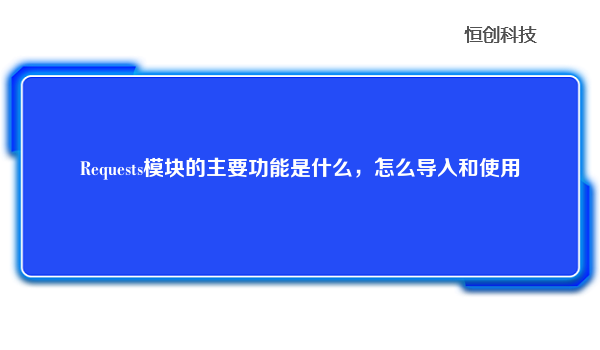
Requests模块是一个用于网络访问的模块,其实类似的模块有很多,比如urllib,urllib2,httplib,httplib2,他们基本都提供相似的功能,那为什么Requests模块就能够脱引而出呢?可以打开它的官网看一下,是一个“人类“用的http模块。那么,它究竟怎样的人性化呢?相信如果你之前用过urllib之类的模块的话,对比下就会发现它确实很人性化。
一、导入
下载完成后,导入模块很简单,代码如下:
importrequests
二、请求url
这里我们列出最常见的发送get或者post请求的语法。
1.发送无参数的get请求:
r=requests.get("http://pythontab.com/justTest")
现在,我们得到了一个响应对象r,我们可以利用这个对象得到我们想要的任何信息。
上面的例子中,get请求没有任何参数,那如果请求需要参数怎么办呢?
2.发送带参数的get请求
payload={'key1':'value1','key2':'value2'}
r=requests.get("http://pythontab.com/justTest",params=payload)
以上得知,我们的get参数是以params关键字参数传递的。
我们可以打印请求的具体url来看看到底对不对:
>>>printr.url http://pythontab.com/justTest?key2=value2&key1=value1
可以看到确实访问了正确的url。
还可以传递一个list给一个请求参数:
>>>payload={'key1':'value1','key2':['value2','value3']}
>>>r=requests.get("http://pythontab.com/justTest",params=payload)
>>>printr.url
http://pythontab.com/justTest?key1=value1&key2=value2&key2=value3
以上就是get请求的基本形式。
3.发送post请求
r=requests.post("http://pythontab.com/postTest",data={"key":"value"})
以上得知,post请求参数是以data关键字参数来传递的。
现在的data参数传递的是字典,我们也可以传递一个json格式的数据,如下:
>>>importjson
>>>importrequests
>>>payload={"key":"value"}
>>>r=requests.post("http://pythontab.com/postTest",data=json.dumps(payload))
由于发送json格式数据太常见了,所以在Requests模块的高版本中,又加入了json这个关键字参数,可以直接发送json数据给post请求而不用再使用json模块了,见下:
>>>payload={"key":"value"}
>>>r=requests.post("http://pythontab.com/postTest",json=payload)
如果我们想post一个文件怎么办呢?这个时候就需要用到files参数了:
>>>url='http://pythontab.com/postTest'
>>>files={'file':open('report.xls','rb')}
>>>r=requests.post(url,files=files)
>>>r.text
我们还可以在post文件时指定文件名等额外的信息:
>>>url='http://pythontab.com/postTest'
>>>files={'file':('report.xls',open('report.xls','rb'),'application/vnd.ms-excel',{'Expires':'0'})}
>>>r=requests.post(url,files=files)
tips:强烈建议使用二进制模式打开文件,因为如果以文本文件格式打开时,可能会因为“Content-Length”这个header而出错。
可以看到,使用Requests发送请求简单吧!
三、获取返回信息
下面我们来看下发送请求后如何获取返回信息。我们继续使用最上面的例子:
>>>importrequests
>>>r=requests.get('http://pythontab.com/justTest')
>>>r.text
r.text是以什么编码格式输出的呢?
>>>r.encoding 'utf-8'
原来是以utf-8格式输出的。那如果我想改一下r.text的输出格式呢?
>>>r.encoding='ISO-8859-1'
这样就把输出格式改为“ISO-8859-1”了。
还有一个输出语句,叫r.content,那么这个和r.text有什么区别呢?r.content返回的是字节流,如果我们请求一个图片地址并且要保存图片的话,就可以用到,这里举个代码片段如下:
defsaveImage(imgUrl,imgName="default.jpg"):
r=requests.get(imgUrl,stream=True)
image=r.content
destDir="D:\"
print("保存图片"+destDir+imgName+"\n")
try:
withopen(destDir+imgName,"wb")asjpg:
jpg.write(image)
return
exceptIOError:
print("IOError")
return
finally:
jpg.close
刚才介绍的r.text返回的是字符串,那么,如果请求对应的响应是一个json,那我可不可以直接拿到json格式的数据呢?r.json()就是为这个准备的。
我们还可以拿到服务器返回的原始数据,使用r.raw.read()就可以了。不过,如果你确实要拿到原始返回数据的话,记得在请求时加上“stream=True”的选项,如:
r=requests.get('https://api.github.com/events',stream=True)。
我们也可以得到响应状态码:
>>>r=requests.get('http://pythontab.com/justTest')
>>>r.status_code
200
也可以用requests.codes.ok来指代200这个返回值:
>>>r.status_code==requests.codes.ok True
四、关于headers
我们可以打印出响应头:
>>>r=requests.get("http://pythontab.com/justTest")
>>>r.headers
`r.headers`返回的是一个字典,例如:
{
'content-encoding':'gzip',
'transfer-encoding':'chunked',
'connection':'close',
'server':'nginx/1.0.4',
'x-runtime':'147ms',
'etag':'"e1ca502697e5c9317743dc078f67693a"',
'content-type':'application/json'
}
我们可以使用如下方法来取得部分响应头以做判断:
r.headers['Content-Type']
或者
r.headers.get('Content-Type')
如果我们想获得请求头(也就是我们向服务器发送的头信息)该怎么办呢?可以使用r.request.headers直接获得。
同时,我们在请求数据时也可以加上自定义的headers(通过headers关键字参数传递):
>>>headers={'user-agent':'myagent'}
>>>r=requests.get("http://pythontab.com/justTest",headers=headers)
五、关于Cookies
如果一个响应包含cookies的话,我们可以使用下面方法来得到它们:
>>>url='http://www.pythontab.com' >>>r=requests.get(url) >>>r.cookies['example_cookie_name'] 'example_cookie_value'
我们也可以发送自己的cookie(使用cookies关键字参数):
>>>url='http://pythontab.com/cookies'
>>>cookies={'cookies_are':'working'}
>>>r=requests.get(url,cookies=cookies)
六、关于重定向
有时候我们在请求url时,服务器会自动把我们的请求重定向,比如github会把我们的http请求重定向为https请求。我们可以使用r.history来查看重定向:
>>>r=requests.get('http://pythontab.com/')
>>>r.url
'http://pythontab.com/'
>>>r.history
[]
从上面的例子中可以看到,我们使用http协议访问,结果在r.url中,打印的却是https协议。那如果我非要服务器使用http协议,也就是禁止服务器自动重定向,该怎么办呢?使用allow_redirects 参数:
r=requests.get('http://pythontab.com',allow_redirects=False)
七、关于请求时间
我们可以使用timeout参数来设定url的请求超时时间(时间单位为秒):
requests.get('http://pythontab.com',timeout=1)
八、关于代理
我们也可以在程序中指定代理来进行http或https访问(使用proxies关键字参数),如下:
proxies={
"http":"http://10.10.1.10:3128",
"https":"http://10.10.1.10:1080",
}
requests.get("http://pythontab.com",proxies=proxies)
九、关于session
我们有时候会有这样的情况,我们需要登录某个网站,然后才能请求相关url,这时就可以用到session了,我们可以先使用网站的登录api进行登录,然后得到session,最后就可以用这个session来请求其他url了:
s=requests.Session()
login_data={'form_email':'youremail@example.com','form_password':'yourpassword'}
s.post("http://pythontab.com/testLogin",login_data)
r=s.get('http://pythontab.com/notification/')
printr.text
其中,form_email和form_password是豆瓣登录框的相应元素的name值。
十、下载页面
使用Requests模块也可以下载网页,代码如下:
r=requests.get("http://www.pythontab.com")
withopen("haha.html","wb")ashtml:
html.write(r.content)
html.close()
到此这篇关于“Requests模块的主要功能是什么,怎么导入和使用”的文章就介绍到这了,更多相关内容请搜索恒创科技以前的文章或继续浏览下面的相关文章,希望大家以后多多支持恒创科技!






.png)

.png)

